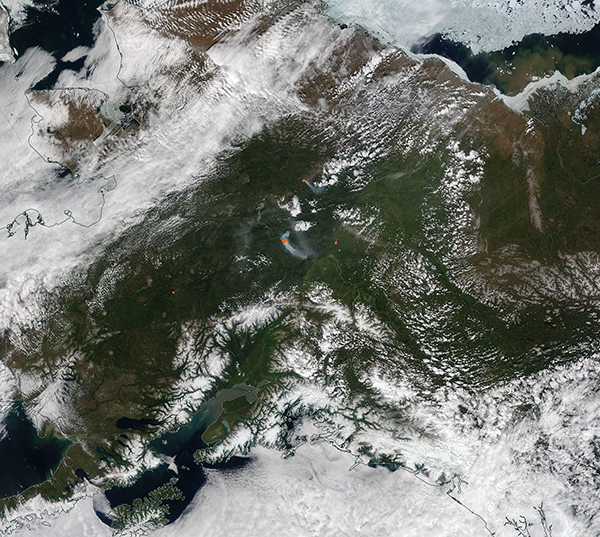Images
June 18, 2021 - Fires near Fairbanks, Alaska
Tweet
The Alaska summer fire season was heating up by mid-June 2021. According to the Alaska Interagency Coordination Center (AICC) Wildland Fire Dashboard, as of June 17 there were 34 fires burning in the state over the last week, with 20 new fires reported in the last 24 hours. Since the beginning of the year, 207 fires have affected 19,015 acres of Alaskan Wildland.
On June 15, 2021, the Moderate Resolution Imaging Spectroradiometer (MODIS) on board NASA’s Terra satellite acquired a true-color image of several large fires near Fairbanks, Alaska. Each red “hot spot” marks an area where the thermal bands on the MODIS instrument detected temperatures higher than normal. When combined with typical smoke, as in this image, such hot spots mark actively burning fires. The two largest fires in this region are the Haystack and the Winter Trail fires, both burning close to Fairbanks.
An outbreak of dry lightning ignited at least eight fires on June 14-15, including the Haystack and the Winter Trail blazes. The Haystack Fire has been burning ominously close to a subdivision, getting within about a mile of the homes. Fortunately, winds were blowing towards the northwest, pushing the fire away from the Haystack subdivision and allowing firefighters to succeed in protecting that area. As of June 17, AICC reports that the Haystack fire has burned 896.5 acres and has been showing “extreme” fire behavior, with spotting, flanking, and backing. The fire is currently about 40 percent contained.
The Winter Trail Fire began with a lightning strike on June 14 about 16 miles northeast of Fairbanks and less than a mile from Fort Knox Gold Mine. As of June 17, the fire had affected about 20 acres. Fire behavior was described as “moderate” by AICC, with smoldering and isolated torching. It has been about 20 percent contained.
Image Facts
Satellite:
Terra
Date Acquired: 6/15/2021
Resolutions:
1km (2.5 MB), 500m (8.5 MB), 250m (19.2 MB)
Bands Used: 1,4,3
Image Credit:
MODIS Land Rapid Response Team, NASA GSFC
Tweet
The Alaska summer fire season was heating up by mid-June 2021. According to the Alaska Interagency Coordination Center (AICC) Wildland Fire Dashboard, as of June 17 there were 34 fires burning in the state over the last week, with 20 new fires reported in the last 24 hours. Since the beginning of the year, 207 fires have affected 19,015 acres of Alaskan Wildland.
On June 15, 2021, the Moderate Resolution Imaging Spectroradiometer (MODIS) on board NASA’s Terra satellite acquired a true-color image of several large fires near Fairbanks, Alaska. Each red “hot spot” marks an area where the thermal bands on the MODIS instrument detected temperatures higher than normal. When combined with typical smoke, as in this image, such hot spots mark actively burning fires. The two largest fires in this region are the Haystack and the Winter Trail fires, both burning close to Fairbanks.
An outbreak of dry lightning ignited at least eight fires on June 14-15, including the Haystack and the Winter Trail blazes. The Haystack Fire has been burning ominously close to a subdivision, getting within about a mile of the homes. Fortunately, winds were blowing towards the northwest, pushing the fire away from the Haystack subdivision and allowing firefighters to succeed in protecting that area. As of June 17, AICC reports that the Haystack fire has burned 896.5 acres and has been showing “extreme” fire behavior, with spotting, flanking, and backing. The fire is currently about 40 percent contained.
The Winter Trail Fire began with a lightning strike on June 14 about 16 miles northeast of Fairbanks and less than a mile from Fort Knox Gold Mine. As of June 17, the fire had affected about 20 acres. Fire behavior was described as “moderate” by AICC, with smoldering and isolated torching. It has been about 20 percent contained.
Image Facts
Satellite:
Terra
Date Acquired: 6/15/2021
Resolutions:
1km (2.5 MB), 500m (8.5 MB), 250m (19.2 MB)
Bands Used: 1,4,3
Image Credit:
MODIS Land Rapid Response Team, NASA GSFC




